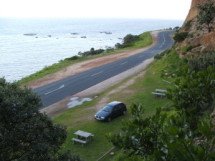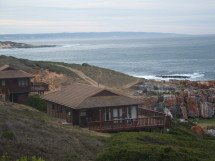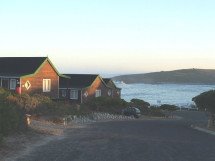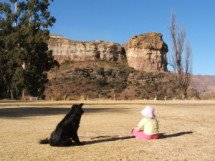 Two South African radio enthusiats in front of a 1922 Gecophone BC2001 'smoker's cabinet' two-valve receiver (Photograph circa 1924).
Two South African radio enthusiats in front of a 1922 Gecophone BC2001 'smoker's cabinet' two-valve receiver (Photograph circa 1924).The following is an interesting and fascinating account of the early days of radio in South Africa during the 1920's as told by late South African Dxer, Nick Kendall (a respected and prominent dxer during the 1970's when I first joined the SADXC).
The candid account, in Nick's own words, provides an insight into what was involved in being able to listen in during those early pioneering days of radio broadcasting.
I have transcribed and edited the 5-part series (with additional information and comments) from the 1978 July - December issues of the SASWL.
Constructing a crystal receiverIt was about 1920 when all my friends were “wireless mad”, some of whom had built crystal sets and some valve sets. One of them said to me, “Why don't you make a crystal set. It is great fun. Come and see mine”.
So we went up to his bedroom and he showed me his set which consisted of a coil of wire around a former about 10 inches x 3 inches (approximately 25 cm x 7 cm) diameter – one end of this connected to the aerial and crystal and the other to earth and one leg of the phone. The other leg of the phones was connected to the “whisker” end of the detector.
 Tuning was effected by a variable condenser “shunted” across the earial and earth. In order to find a “sensitive spot” on the crystal, somebody pressed an electric bell-push. The detector would pick up the spark made by the break - and break on the bell. Then you were all set to listen in.
Tuning was effected by a variable condenser “shunted” across the earial and earth. In order to find a “sensitive spot” on the crystal, somebody pressed an electric bell-push. The detector would pick up the spark made by the break - and break on the bell. Then you were all set to listen in.All there was to hear were ships (if you were lucky) in morse code (CW) and the time signal from Slangkop Light House at 11:00 pm. Anyhow, I got bitten and made up a crystal set and listened to ships on 600 metres.
 Slangkop lighthouse, situated at the southern boundry of Kommetjie, Cape Peninsula. A radio station with a 5 kw Marconi transmitter was established on the seaward slopes of Slangkop in 1912. The station was later relocated to Kommetjie (Photograph Wikimedia Commons).
Slangkop lighthouse, situated at the southern boundry of Kommetjie, Cape Peninsula. A radio station with a 5 kw Marconi transmitter was established on the seaward slopes of Slangkop in 1912. The station was later relocated to Kommetjie (Photograph Wikimedia Commons).John Samuel Streeter's early record broadcasts
In 1919 radio amateur John Streeter began broadcasting records on Tuesday and Thursday nights on 200 metres (initially from Sea Point and then Observatory, Cape Town - GD). It was so weak on the crystal set that I decided to build a one valve set.
(Two other prominent amateur radio enthusiasts also began broadcasting in 1919 :
Reginald Hopkins broadcast pianola music and messages from his home in Wynberg, Cape Town. With local newspaper publicity, both Cape Town stations became popular and were received across the Cape Peninsula and thoughout the Cape Province including the Karoo region of South Africa.
Further north, Arthur Sydney Innes was very successful with his broadcast of gramophone recordings from his radio station, known as 2OB, located in Observatory, Johannesburg - GD).
 Arthur Sydney "Toby" Innes, broadcasting from his radio station 2OB, situated in Observatory, Johannesburg. Standing behind is Alf Goodman who became a well known radio enginner with the SABC (Photograph circa 1922).
Arthur Sydney "Toby" Innes, broadcasting from his radio station 2OB, situated in Observatory, Johannesburg. Standing behind is Alf Goodman who became a well known radio enginner with the SABC (Photograph circa 1922).Constructing a one valve receiver
I went to R.M. Ross & Co. (where Electricity House is today) and saw Mr. Smith who had helped me with my crystal set and bought the necessary parts : A 60 volt H.T. Battery, a 2 volt accumulator, a rheostat (for reasons unknown in those days , each valve filament had to be controlled by its own rheostat). I built my one valve set and Mr. Streeter was so loud that he had to be de-tuned. I still remember his signature tune, “Carry Me Back To Ole Virginny”.
2LO London
2LO London had just begun to broadcast and people here were trying to pick them up – the power used was 1.5 kw. Occasionally, due to unusual reception conditions they were heard here.
(2LO commenced broadcasting on 350 metres with 100 watts on the 11th May 1922 - a more advanced 1.5 kw transmitter was rebuilt and installed soon afterwards during that year, in line with new regulations which allowed for the increase in transmitter power.
The 2LO antenna, situated on top of Marconi House in London, consisted of a 100 ft long two cage system of four wires each and was suspended between two 50 ft masts - GD).
6BM Bournemouth
I tried with my own one valve set and one night as I took my hand off the condenser knob, I heard music. Boy, was I exited. As long as I kept my hand just poised above the condenser, the signal stayed. Fortunately, I was able to rest my elbow on the table so that it was not so tiring. This was not 2LO – the wavelength (frequency was not used in those days) was not right and it turned out to be 6BM Bournemouth. Like Sullivan's “lost Chord” it was not heard again.
(A sensational catch! 6BM commenced broadcasting on 385 metres with 1.5 kw on the 17th October 1923 - GD).






















No comments:
Post a Comment